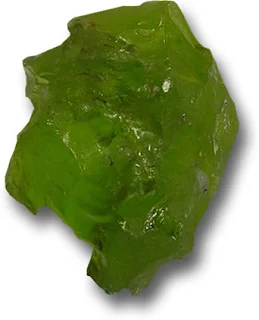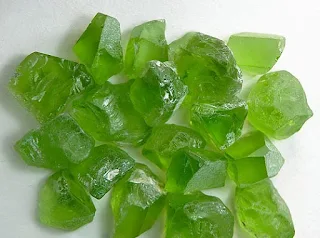
Peridot is a well-known and ancient gemstone, with jewellery pieces dating all the way back to the Pharaohs in Egypt. The gem variety of the mineral Olivine, it makes a lovely light green to olive-green gemstone. The intensity of colour depends on the amount of iron present in a Peridot's chemical structure; the more iron it contains the deeper green it will be. The most desirable colour of Peridot is deep olive-green with a slight yellowish tint. Deeper olive-green tones tend to be more valuable than lighter coloured greens and yellowish-greens.
Peridot is the gem variety of the mineral olivine. Its chemical composition includes iron and magnesium, and iron is the cause of its attractive yellowish green colours. The gem often occurs in volcanic rocks called basalts , which are rich in these two elements.

The superb yellow-inexperienced Peridot has been under-liked for years, overlooked as a lesser gem, small, easily received and comparatively inexpensive, frequently considered as genuinely the birthstone for August. Its reputation has fallen inside and outside of fashion for hundreds of years. However, a new resurgence is bringing to light what Peridot fans have always acknowledged: this is a certainly wonderful stone.
Called “the extreme gem” by the Gemological Institute of America, Peridot is born of fire and brought to light, one of only two gems (Diamond is the other) formed not in the Earth’s crust, but in molten rock of the upper mantle and brought to the surface by the tremendous forces of earthquakes and volcanoes. While these Peridots are born of Earth, other crystals of Peridot have extraterrestrial origins, found in rare pallasite meteorites (only 61 known to date) formed some 4.5 billion years ago, remnants of our solar system’s birth. Peridot in its basic form, Olivine, was also found in comet dust brought back from the Stardust robotic space probe in 2006, has been discovered on the moon, and detected by instrument on Mars by NASA’s Global Surveyor. Ancients believed, quite accurately, that Peridot was ejected to Earth by a sun’s explosion and carries its healing power.

Peridot is a gem-quality variety of the mineral olivine. It belongs to the forsterite-fayalite mineral series. Some even refer to peridot as 'olivine', but when it comes to the gemstone, 'peridot' is the correct term. Peridot is an idiochromatic gem, meaning its colour comes from the basic chemical composition of the mineral itself and not from minor traces of impurities. Thus, peridot is found only in green. In fact, peridot is one of the few gemstones available that can be found only in one color, although the shades of green may vary from light yellowish to dark brownish-green.
The name 'peridot' was derived from the Arabic word for gem 'faridat'. It is sometimes referred to as 'the poor man's emerald ' or as 'chrysolite', a word derived from the Greek word 'goldstone'. It is one of the oldest known gemstones, with records dating back as early as 1500 B.C. Historically, the volcanic island of Zabargad (St. John) in the Red Sea, east of Egypt, had the most important deposit that was exploited for over 3500 years. Today, the finest quality peridot comes from Mogok in Burma, although Pakistani peridot is now highly regarded as well. There are other very important deposits found in Arizona, China and Vietnam. Peridot has also been discovered in fallen meteors and it has also been discovered on Mars and the moon in olivine form.

Olivine, of which peridot is a kind, is a common mineral in mafic and ultramafic rocks, and it's miles regularly found in lavas and in peridotite xenoliths of the mantle, which lavas carry to the surface; however gem high-quality peridot handiest happens in a fragment of those settings. Peridots may be additionally located in meteorites.
Olivine in fashionable is a very plentiful mineral, but gem first-rate peridot is alternatively uncommon. This is because of the mineral's chemical instability on the Earth's floor. Olivine is normally determined as small grains, and tends to exist in a closely weathered kingdom, mistaken for ornamental use. Large crystals of forsterite, the range most customarily used to reduce peridot gem stones, are uncommon; as a result olivine is taken into consideration to be precious.
Peridot crystals have been accumulated from a few pallasite meteorites.
Chemically, peridot is an iron magnesium silicate and its intensity of colour depends on the amount of iron it contains. There may also be traces of nickel and chromium present. Peridot is not especially hard and it has no resistance to acid. On very rare occasions, peridot is known to form with cat's eye chatoyancy (asterism) in the form of four ray stars. Peridot can be mistaken for similar coloured gems, but its strong double refraction is often a very distinguishing trait. In thicker stones, the doubling of lower facet edges can be easily seen by looking down though the table without the need for magnification.

Most gemstones are formed in earth's crust, but peridot is formed much deeper in the mantle region. Peridot crystals form in magma from the upper mantle and are brought to the surface by tectonic or volcanic activity where they are found in extrusive igneous rocks. Historically the volcanic island Zabargad (St. John) in the Red Sea was the location of the most important deposit. It was exploited for 3500 years before it was abandoned for many centuries; later, it was rediscovered around 1900 and has been heavily exploited ever since.
Today, the maximum crucial deposits are found in Pakistan (inside the Kashmir area and the Pakistan-Afghanistan border vicinity). Beautiful fabric is likewise discovered in upper Myanmar (Burma) and Vietnam. Other deposits are found in Australia (Queensland), Brazil (Minas Gerais), China, Kenya, Mexico, Norway (north of Bergen), South Africa, Sri Lanka, Tanzania and the United States (Arizona and Hawaii). Recently, China has grow to be of the the largest manufacturers of peridot.
Peridot is a obvious gem variety of olivine. Olivine isn't formally a mineral however consists of stop-member minerals: fayalite and forsterite. Fayalite is iron wealthy olivine, while forsterite is magnesium rich olivine. Although iron is the colouring agent for peridot, it's far technically closer to forsterite than fayalite in regards to chemical composition.
Peridot is sometimes referred to as 'chrysolite', a historical name which archaically refers to several green to yellow-green coloured gemstones. Other forms of 'chrysolite' include chrysoberyl , zircon, tourmaline, topaz and apatite.

Peridot is pretty useful for attuning to and regulating the cycles of one?S existence, together with bodily cycles, mental or emotional levels, as well as intellectual progression. It also enables deplete negative patterns and antique vibrations that play again and again, preserving one from realising they may be deserving of fulfillment. By running with Peridot possible get rid of those blockages and flow ahead quickly, starting the heart and mind more absolutely to acquire from the Universe with grace and gratitude.
A stone of transformation, Peridot is awesome for use in healing from tobacco or inhalant dependencies, as well as other addictions. More importantly, it's far a wounded healer stone, serving as a critical guide in facilitating recuperation processes that help others going via what you've got already triumph over. It is considered very effective in amplifying Reiki energies. Hold right away after remedies the use of heat or warm temperature, together with sweat resorts, hot rocks or a sauna to preserve the useful results.
Peridot is ideal for discharging emotional troubles that have an effect on the bodily body. Place it over the Solar Plexus to relax and launch anxious tension, called ?Butterflies,? As well as to relieve fear and guilt, anxiety or impatience. Place Peridot over the Heart Chakra to alleviate heaviness of heart, empower forgiveness, or alleviate detrimental jealousy or self-doubt due to betrayal in beyond relationships.
Use Peridot to advantage effects whilst searching for items that are lost or mislaid inside the bodily global, as well as within the quest for an enlightened country.
Wear Peridot set in gold to deliver non violent sleep. It is specifically powerful for individuals who suffer from recurring nightmares about evil spirits, murders or sexual assaults.
Wear or bring Peridot as a talisman of luck and as a solar stone to prevent non-public darkness. It provides attraction and eloquence to your displays, evokes a nice, helpful reaction from generally unhelpful people, and increases profit in trades. It is obviously protective towards envy, gossip behind your back, and those who might lie to you.
| Chemical Formula | (Mg,Fe)2SiO4 |
| Colour | Green, Yellow |
| Hardness | 6.5 - 7 |
| Crystal System | Orthorhombic |
| Refractive Index | 2.63 - 2.65 |
| SG | 1.54 - 1.55 |
| Transparency | Transparent |
| Double Refraction | .009 |
| Luster | Vitreous |
| Cleavage | 2,1 ; 3,1 |
| Mineral Class | Olivine |






